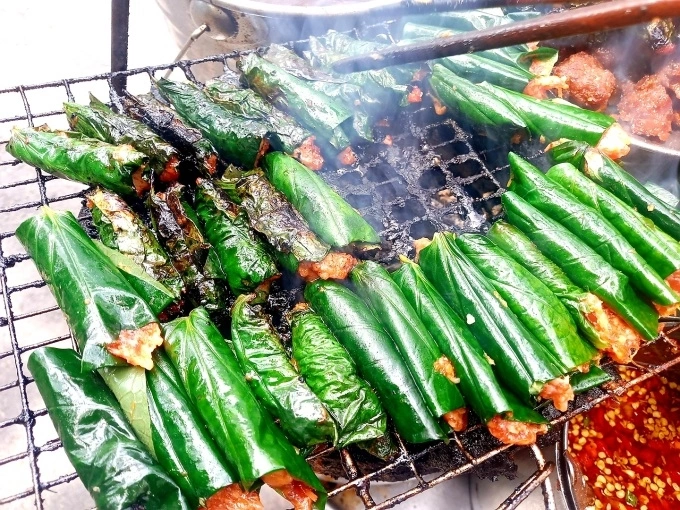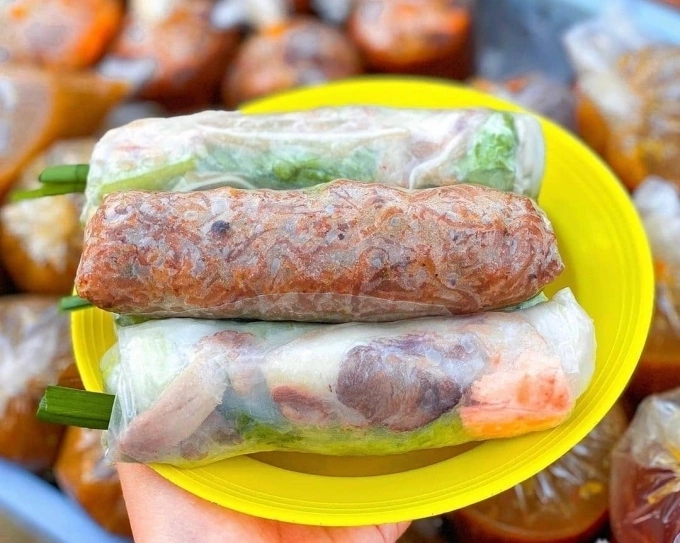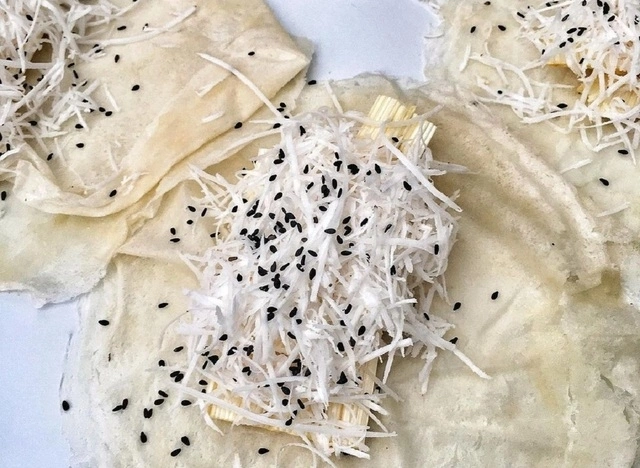1. Goi cuon – Fresh spring rolls
Goi cuon, or fresh spring roll, is most likely the roll that most people are familiar with. A transparent rice paper wrapper, cooked shrimp or pork, vermicelli noodles, and greens like lettuce, mint, beansprouts, and cucumber slices are used to make fresh spring rolls. Customers are immediately impressed by the roll's appearance because of the shrimp, which has an eye-catching red color, and the green vegetables underneath the wrapper. Fresh spring rolls are a common snack sold by street vendors in Saigon as well as a traditional appetizer in many areas of the country.
If you're looking for a dish that is at once light, healthy, and delicious, this is it. The dipping sauce has two basic versions: sour and sweet garlic chili fish sauce and a mixture of hoisin and peanut sauce. The dipping sauce will hit you with exactly the right amount of sweetness and nutty flavor from the first bite. You'll want to keep eating more because of the delicious flavor of the grilled pork and prawns, and the freshness of the greens. A vegan variation with tofu and mushroom filling is also available in some places.

2. Cha gio - Fried spring rolls
Fried spring rolls and fresh spring rolls are known throughout the world as the iconic Vietnamese duo rolls. While fresh spring rolls can be consumed immediately after being made, cha gio has to first be deep fried. Spring rolls are made by wrapping filling clear rice paper wrappers. Depending on the region, the filling may have slightly different ingredients, but it normally includes ground pork, vegetables, wood ear mushrooms, and glass noodles. The rolls are fried until golden and crispy. And they're often served wrapped with lettuce and herbs, with a dipping sauce made of fish sauce and sugar.
Fried spring rolls are also known as nem ran in Hanoi. You'll be hooked by the smell and they are also crispy and savory. Not only will each region have its own version of this spring roll, but each family will have their own customized recipe, allowing you to have different experiences when eating spring rolls.

3. Banh trang cuon thit heo - Rice paper rolls with pork
Banh trang cuon thit heo - rice paper rolls with pork - is a Da Nang specialty. The name includes both of its two main components as well as its preparation method. Each order includes big slices of boiled or roast pork, and vegetables such as lettuce, cucumber slices, Thai basil, banana blossoms, mint, and coriander. The best cut of pork, with a good balance of meat to fat, is used for this dish. Fresh banh pho, which are flat rice noodle sheets that can be cut into pho noodles, and rice paper wrappers are combined to form the wrappers.
What makes this dish stand out is the dipping sauce called mam nem, or fermented fish sauce.
The sauce, which is made of fermented anchovies, sugar, Thai chili pepper, garlic, lemongrass, sugar, and crushed pineapples, is an irreplaceable companion to this dish.
Making the rice paper rolls with pork takes some time, patience, and effort, as diners have to make their own rolls. This sets this dish apart from its cousin, fresh spring rolls, which can be purchased from street vendors and eaten while on the road.
You need to put the rice paper wrapper on top of the rice noodle sheets, add a thin slice of pork and other greens, and then roll it up into a complete roll. The pork slices taste flavorful, sweet, tender, and fat-free. You can appreciate how delicious this dish is when you eat the roll with the dipping sauce. This fishy and sour flavor may come as a surprise if you're not very familiar with fermented fish sauce.
4. Pho cuon - Pho rolls
Foodies all over the world are familiar with pho, but unless you're a local, you probably haven’t heard of pho rolls. Many Hanoians adore pho rolls, which may be eaten as a quick snack or a complete dinner. Despite having both beef and fresh banh pho - flat rice noodle sheets that can be cut into pho noodles – pho roll doesn't taste anything like the traditional pho noodle soup.
A pho roll consists of flat rice noodle sheets, stir-fried beef, and lettuce. The northern style dipping sauce is less sweet and more subdued than the southern style, despite the fact that both use fish sauce as their primary ingredient.
Although the dish's concept is so straightforward, I've never been let down by its flavor. The combination of the fish sauce and the flavorful, savory stir-fried beef is superb. Five to 10 rolls can be easily consumed by one adult without feeling bloated.

5. Nem nuong - Vietnamese grilled pork sausage
Although it originated in Nha Trang, nem nuong, Vietnamese grilled pork sausage, is now available in other cities, including Hanoi and Ho Chi Minh City. The pork sausage is garlicky with a hint of sweetness and is traditionally grilled over charcoal. A regular set comes with grilled pork sausage, crisp fried rice paper, fresh veggies, and a special dipping sauce. To enjoy this dish, you can wrap the sausage in the rice paper along with other greens, dip it in the sauce, and then take a big bite. Pork, pork liver, fish sauce, sugar, garlic, and sweet rice are the main ingredients in the sauce.
The satisfied feeling that this dish brings is indescribable. Almost all of the savory and sweet flavors of the sausages and the sauce can be tasted at the same time. The grilled pork sausage is without a doubt the best part of this cuisine. The texture is firm and springy, plus it smells fantastic. If you’re planning to visit Vietnam, this is one of the foods you really should try.

Grilled pork sausage is served with different kinds of vegetables. Photo by VnExpress
6. Bo cuon la lot - Grilled beef in wild betel leaves
In Saigon, bo cuon la lot, or grilled beef wrapped in wild betel leaves, is a particularly well-liked street food. The main star of this dish is the ground beef, which is marinated, wrapped in wild betel leaves, and roasted over charcoal. Along with a sweet and sour dipping sauce on the side, it is served with roasted peanuts, chopped lettuce, and Vietnamese herbs. The most common way to eat bo cuon la lot is wrapping it in rice paper, topped with vermicelli noodles, pickles, veggies, and herbs.
People are drawn in by the alluring aroma of spiced grilled beef wafting through the air as they stroll through Saigon's streets in the afternoon. In addition to the typical dipping sauce, you can try a unique sauce called mam nem. The fermented fish sauce is highly recommended if you're a courageous eater who wants to enjoy this dish in the fashion of the locals.

Food enthusiasts are drawn to the scent of grilled beef in wild betel leaves. Photo by VnExpress
7. Bi cuon - Shredded pork skin rolls
Bi cuon, or shredded pork skin fresh spring roll, is typically found on the buffet table. The roll is stuffed with lettuce and herbs, as well as shredded pork skin and pork. The shredded pork skin and roasted rice powder are combined to create a dish with a well-balanced flavor and chewy texture. It is served with a fish sauce containing pickled daikon and carrots, or sometimes peanut sauce.
Shredded pork skin roll is a great option for a low-carb menu because they contain lots of greens and no noodles. Moreover, the shredded pork skin is mixed with roasted rice powder, which makes it non greasy and has an iconically smoky flavor. This is an ideal light snack to give you a short-term boost of energy before dinner.

8. Banh uot cuon - Steamed cake rolls
The way that steamed cake rolls are served differs significantly from the ways that the other dishs on this list are prepared. Although steamed cake rolls may not be as well-known as the other rolls, this does not make it any less delicious. Customers are given a stack of steamed rice cakes that are used as wrappers in place of the usual rice paper. Steamed cake rolls surprise diners with its various selection of fillings to choose from, such as grilled meat, grilled pork sausage, pop rice pork ham and fermented grilled pork.
It is advised to add side dishes like shredded cucumber, shredded green mango, pickled mustard greens, and basil leaves to a roll to make it complete. If you think that's a lot, you'll be shocked by the four different dipping sauces that come in the set. These include sweet fish sauce, pork sauce, garlic-chilli fish sauce, and fermented anchovy sauce.
Each bite will be a new and flavorful treat. You can further explore a variety of flavors by varying the sauces in addition to changing the fillings. The meats are rich and tasty, and the vegetables add a pleasing crunch and consistency. The fact that the cakes are served on multiple plates ensures that you have a stunning stack of finished plates as evidence of your hard work, making eating the cakes a truly enjoyable experience. I believe that my ability to consume 20 plates of the steamed cake on my first try has demonstrated how enjoyable this dish can be.

9. Bo bia - popiah
Bo bia, or popiah, is a popular street snack that can be found at street vendors, especially in front of schools. The immigrants from Chaozhou brought this dish to Vietnam, where it was slightly modified to suit local preferences. In Vietnam, popiah comes in two versions, savory and sweet. The savory popiah is made with ingredients such as sausages, eggs, carrots, lettuce, jicama, or kohlrabi, dried shrimp, and herbs, all chopped and rolled in rice paper. The sauce served with this is chili sauce mixed with roasted peanut butter and fried onions.
The sweet popiah is simpler to make as the filling includes a crispy sugar candy, shredded coconut, and some black sesame seeds.

It was a novel and unexpected experience for me as a Hanoian to try savory popiah in Saigon, since there is only sweet popiah in Hanoi. The savory popiah has the ideal amount of fresh crunchy vegetable and sausage flavor that is both sweet and savory. Even though the southern-style popiah is delicious on its own, dipping it in the nutty and spicy sauce elevates the taste even further.

Phuc Trinh